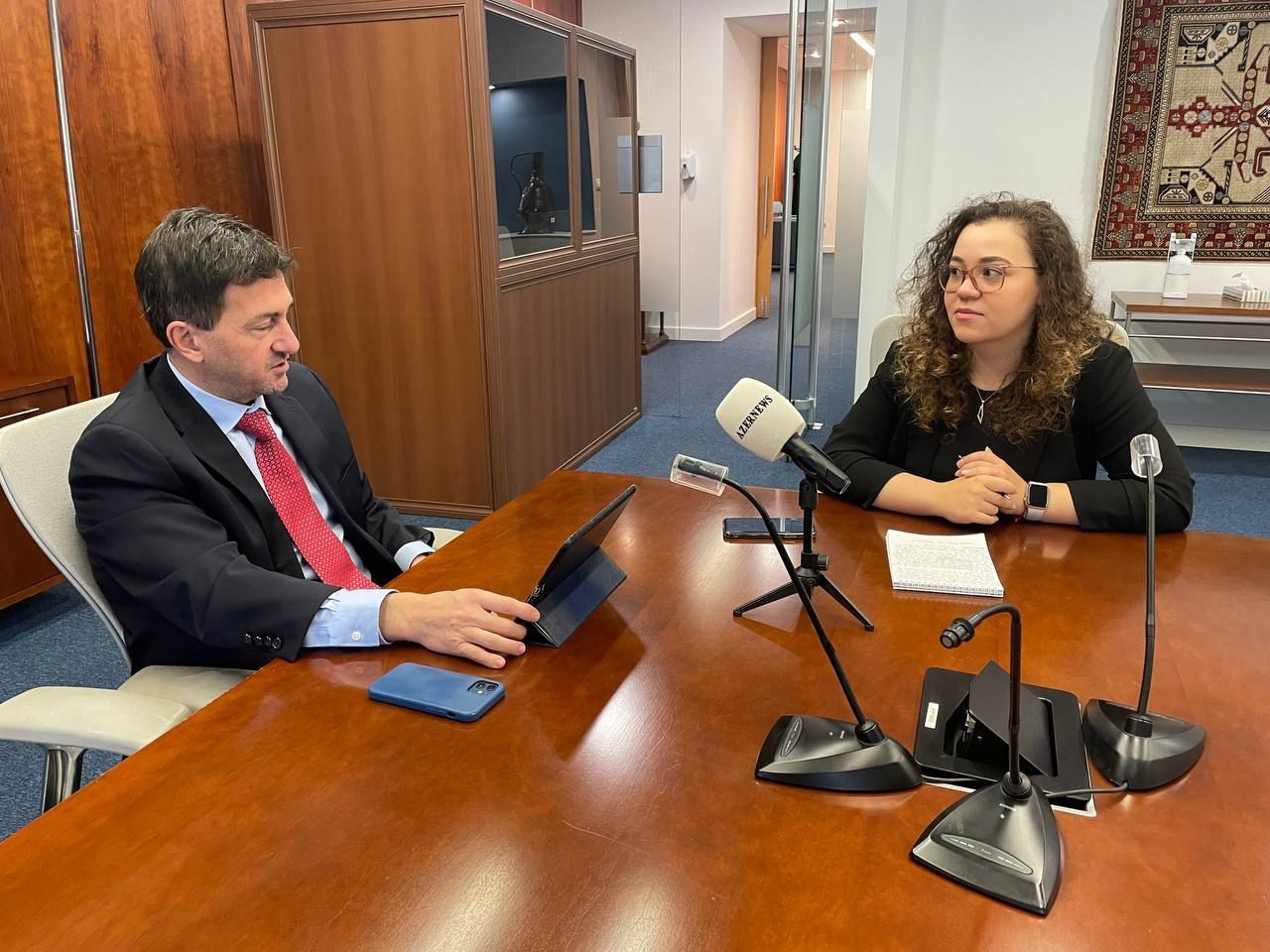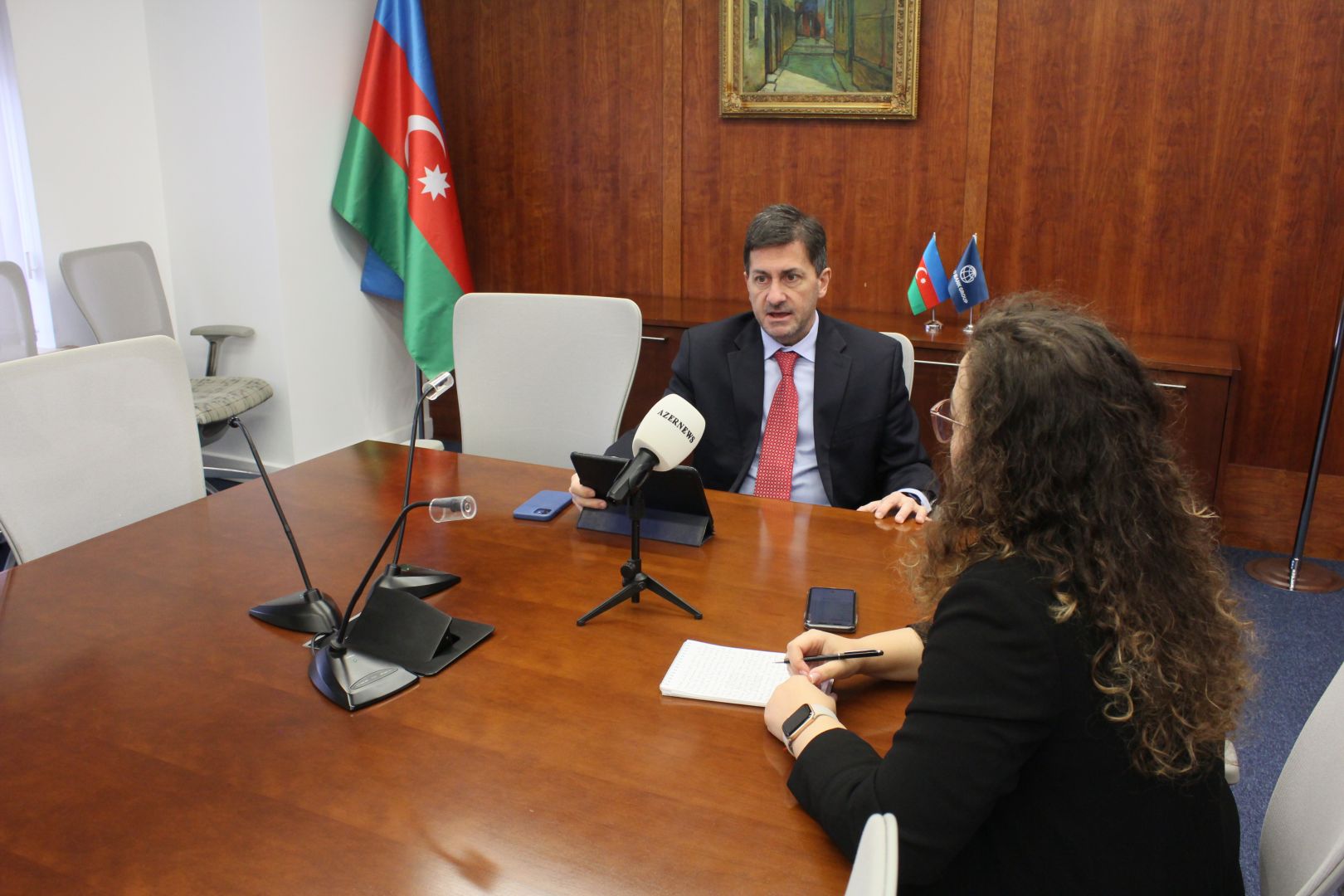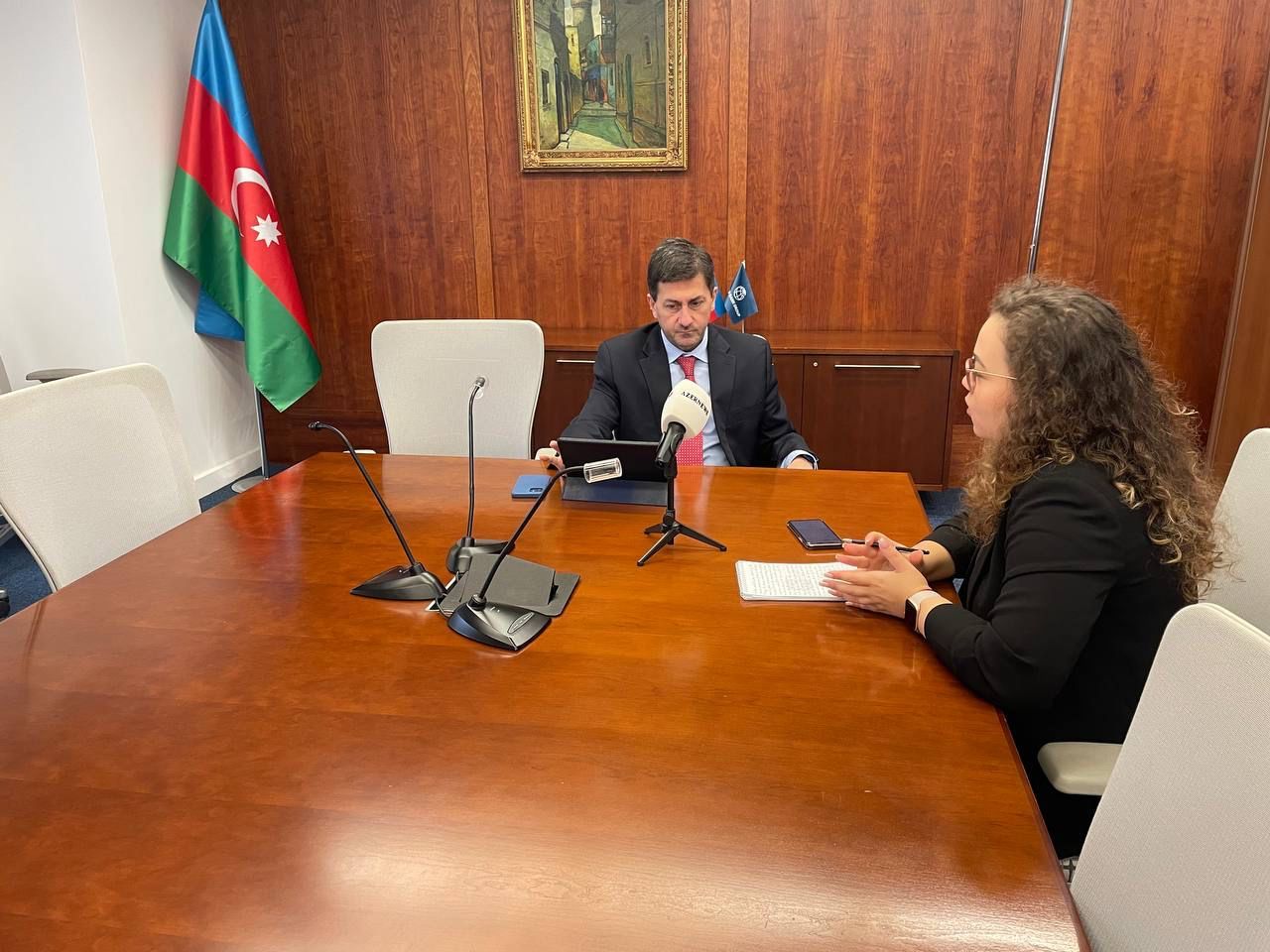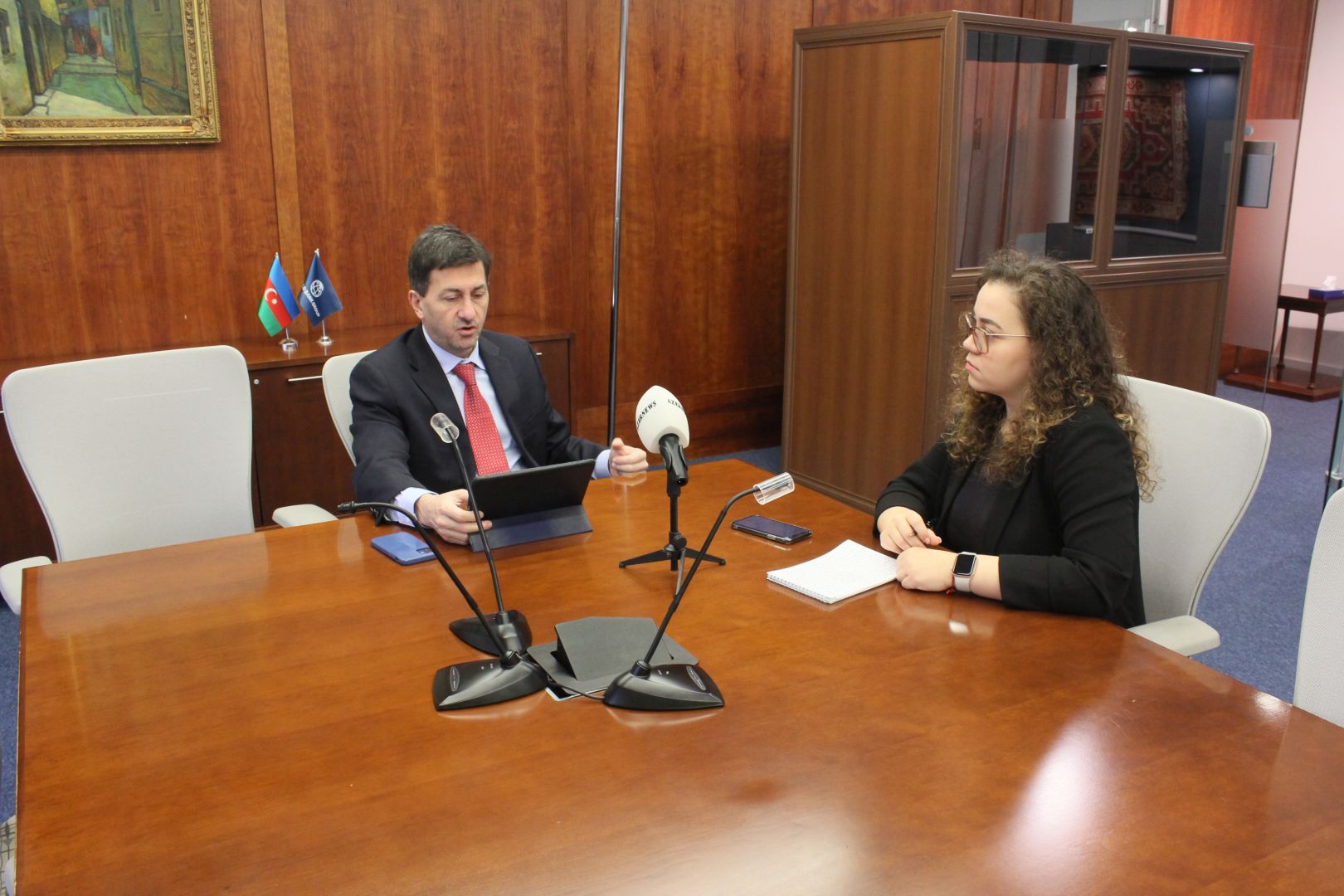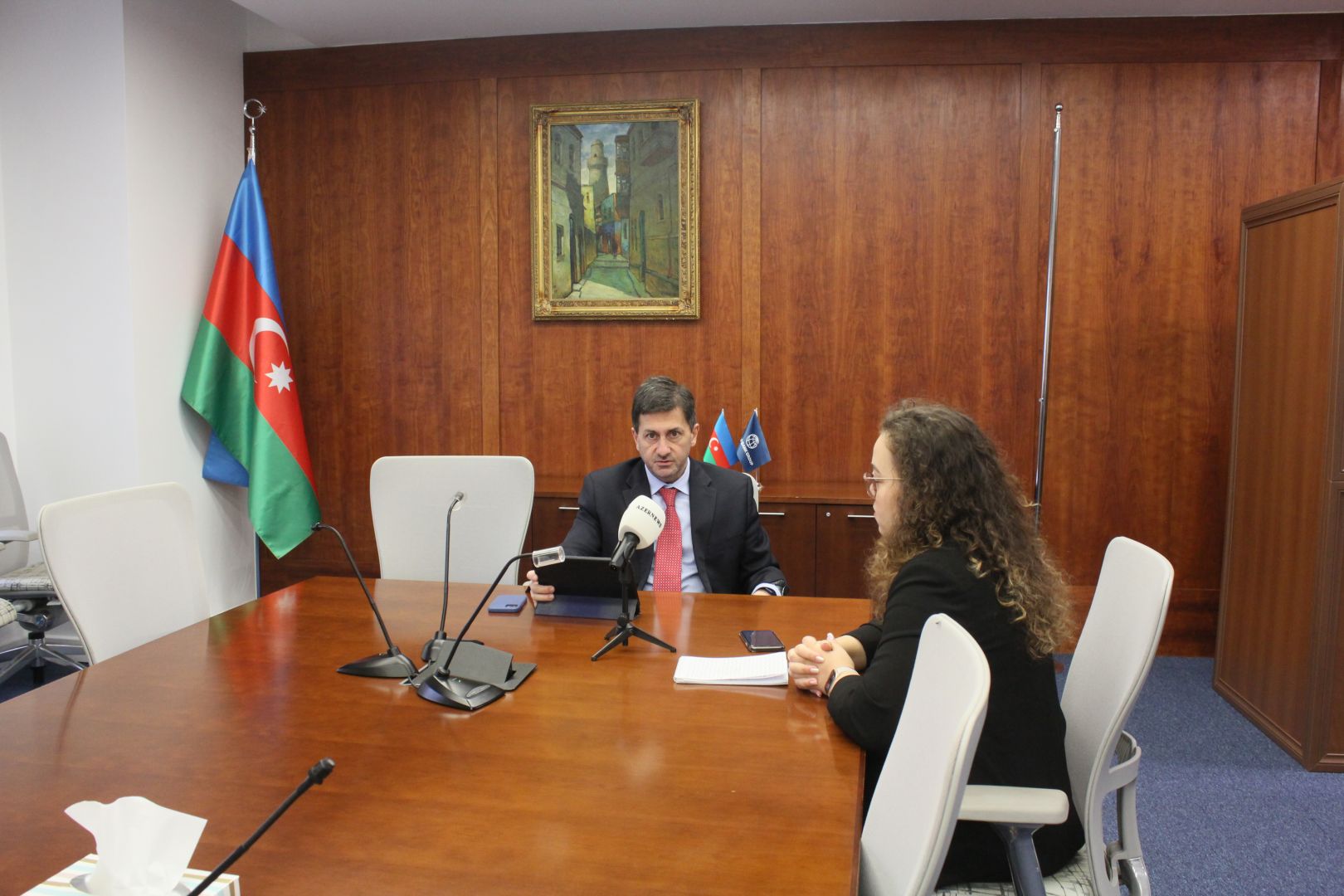WB expert upbeat about Azerbaijan's macroeconomic situation, economic growth & integration into global economy [INTERVIEW]
![WB expert upbeat about Azerbaijan's macroeconomic situation, economic growth & integration into global economy [INTERVIEW]](https://www.azernews.az/media/2022/12/12/16665862476405149.jpg)
The World Bank presented Azerbaijan Country Economic Memorandum (CEM) report at ADA University in Baku on December 8.
Ayya Lmahamad of Azernews in an exclusive interview with Antonio Nucifora, Practice Manager, Macroeconomics, Trade and Investment at the World Bank, spoke about the findings of the report, Azerbaijan's current macroeconomic situation, key drivers of the economic growth, the country's economic integration into the global one, as well as gave recommendations on how to improve the economic situation, how to be better prepared to certain global challenges and how to achieve objectives of the national priorities roadmap.
Q: What would be your assessment of the current macroeconomic situation in Azerbaijan?
A: I think the Azerbaijani economy is doing very well currently. We know that the economic growth has been 5.2 percent year-on-year by the end of the third quarter, as energy sector output fells somewhat, but non-energy sector growth remains very strong at about 10 percent year-on-year in September. Looking ahead to the end of the year, we still see growth, maybe not as strong as the third quarter, but still around 4.5-5 percent, so very significant.
Inflation, however, is quite high, it surged in September up to about 15.5 percent again of the twelve months, and this continues to be a sort of area of concern. Inflation rose about 3 percent month-on-month in September. And the concern is really in food inflation, which has been rising by almost 22 percent over a year. Now, the authorities, of course, are aware of this, the Central Bank has been tightening monetary policy recently by a quarter of a point in November, taking the policy rate to 8 percent. So it is being managed and it is something that continues to need attention.
The trade surplus is very healthy. There is a trade surplus of almost 33 percent from the beginning of the year to September, driven mainly, of course, by oil and gas, and this is over seated strong growth in imports.
Also in terms of the public finances, the performance has been very strong, driven by the high global energy prices. There has been a strong increase in revenues, but also spending has been boosted. Overall the government has recorded, as of September, a 2 percent surplus. And finally, I think credit to the economy remains quite healthy since there is a lot of activity and a lot of investment plans with credit growth by about 9 percent in real terms and about 24-25 percent in nominal terms over the first nine months of the year. And the banking sector remains quite profitable.
Q: Though the country’s economic development is tightly linked to global oil prices and energy resources as a whole, Azerbaijan has been experiencing economic growth. In your view, what factors and sectors of the economy have been key drivers for the economic growth in the country over the recent years?
A: I think there are two or three factors that are worth noting. The first one is that there has been strong non-oil, non-gas, non-energy sector growth, which has been supporting a healthy level of growth. Part of this has been the recovery of the traditional services from the Covid period, from the restrictions. There has been a bounce back, you know, we are talking about transport, hospitality, also ICT, quite a big bounce back and that has contributed, as restrictions were removed.
Secondly, there was a lot of, what economies called pent-up demand. There is a return to spending, which is boosting consumption, and this has also been complimented, as I mentioned earlier, by an increase in government spending. So this spending is helping the economy to increase economic activity. The war in Ukraine has had muted somewhat positive impact on the economy in Azerbaijan, mainly because of the transport sector. So a lot of activity has been rerouted in a way through Azerbaijan. And so the result of the role also has been pushing tourism and hospitality, again pushing ICT and non-oil manufacturing, as a lot of the demand, a lot of the activity has shifted from, in a way Europe towards Central Asia and the Caucasus.
And finally also the benefit in terms of pickup in remittances from Russia, including thanks to the strengths of the ruble in recent months. So all of these factors together have contributed in the last couple of years to accelerate the recovery from Covid and to put the Azerbaijani economy on a good growth footing.
Q: How can Azerbaijan secure and sustain economic growth over the long run? What are your policy recommendations for improving the economic situation in the country?
A: This is a bigger challenge, and of course, we all know that the growth model of Azerbaijan is looking ahead and is reaching its limit; it’s of course in the government strategy. There is a need for a new growth model which is centered on private sector-led growth. And so creating the conditions for a dynamic non-energy related, so beyond energy, the private sector is fundamental.
At the World Bank, we have recently launched a report that looks at the economic challenges for Azerbaijan and the economic future of Azerbaijan. And we see that there is a risk that over the long term the economic growth will slow down, to almost 1.5 percent per year, if no changes are done. At the same time, on a positive message, we see that there is a way to very much increase this potential by pursuing this transformation of the economic growth model, such that per capita incomes could be 40 percent higher, you know, looking ahead also by 2050 if the right policies are adopted.
And the key is really this - moving towards the private sector that can be productive, more productive than the current state-owned enterprises, which are present in most sectors of the economy, and also looking at the economy which is well integrated into the global system. This is important because we know that worldwide, not a single country with a population of 10 million, such as Azerbaijan and below, not a single country has been able to make it to high-income status without being substantially integrated into the global economy. And the reason is very simple - market access. You know, when you are a population of relatively small countries you do need access to the global markets in order to be able to grow.
The other thing that you need is to be competitive in those markets. And so, in order to have a competitive private sector, you need to create a level playing field removed to distortions, and facilitate the contestability of the markets domestically, which will indeed make firms efficient and able to sell in the global markets, and gain market share. And for that, you also need access to skilled labor. So investment in human capital is fundamental.
And, of course, this also matches the opportunities that are coming from the digital economy, the innovation economy. So creating a private sector that is dynamic, with a level playing field, opening up the economy to the global markets, investing in human capital and digital, and I would say also that, related to all of these, in terms of integration is creating an environment, which is attractive to investment, also foreign investment. Because, nowadays, with the highly globalized world that we have, most of the trade and integration is run to the global value chains, and that is really led by the foreign investments, that finds it attractive to produce one part of this big global value chain into the country. And so that global investors bring in the knowledge, bring in the contacts, the ability to then sell globally. And so, having an environment, which also enables and attracts foreign investors is important.
So all these pieces are important, the integration, the climate for investment, including foreign investment, the domestic competition and the level of playing field, and also the human capital. There is one final point that I would like to mention, which is the government is already investing in the direction of a green economy with renewable energies, and I think that this is very much is also a part of the future. So when I look at the prospects, at the potential of Azerbaijan in the future, I think that this area will be fundamental, because it is an area where the entire world is moving. And for Azerbaijan, of course, it is both an opportunity and also a necessity, in terms of changing the economic growth model.
Q: I think, you already partially mentioned the answers for our next question, as it is linked somehow with the previous one, but maybe you would like to add something else. So, in February 2021, the government’s “Azerbaijan 2030: National Priorities for Socio-Economic Development roadmap” was approved, which envisages the vision for the country’s long-term development priorities. In your opinion, what Azerbaijan needs (to do) in order to achieve these objectives?
A: First of all, yes, as you said it is linked a little bit to my previous answer. In this report, that we presented, it is called Azerbaijan Country Economic Memorandum, we had several pillars to achieve the new growth model. And it is in a way very much aligned with supporting the sort of priorities, the vision of the government for the indeed the 2030 national socio-economic development roadmap. What we see, is that at the core is indeed achieving this transformation in the role of the state. In order to achieve the new growth model, that we talked about, there is a need to achieve the transformation in the role of the state, from the state that is an active investor and participant in the economy to a supportive state, that is focused on providing the right environment, as we said, for the private sector, for the investment, for the ability to integrate globally. And as part of achieving this, in the CEM report for Azerbaijan, we outlined three important pillars.
The first one is indeed strengthening the economic management to reduce macroeconomic volatility so that we avoid a sort of booming by cycle which is often associated with the energy prices cycles. So that is important to create an environment that is secure, that is stable, that can facilitate vision and the investment of the private sector outside of the energy sector, or outside of the oil and gas sector, I should say.
The second is indeed improving productivity in the non-energy sectors. This passes through a rethinking, and reforming of the state-owned enterprises, to make SOEs more efficient, to improve their financial performance, and to ensure that there is what economies called competitive neutrality, meaning that you don't want to put the SOEs in the privileged space by giving them support, by giving them special advantages because that will make it impossible for the rest of the private sector to compete, and therefore to grow. So if the objective is to make the rest of the private sector grow you need to make the right environment, which doesn't mean removing the SOEs but means having the SOEs compete with everybody else and enable this healthier economic environment.
And this is indeed the key to supporting a dynamic private sector, and then there are also a number of reforms beyond these fundamentals that are needed. Access to finance we know is a key challenge, especially for smaller enterprises. We talked about the importance of skills, which is really significant core strength for the private sector in Azerbaijan, and as I mentioned it is both important for the private sector, and also important in terms of taking advantage of the digital economy, so more innovation, IT based future markets. So this is on top of the basic that we say the integration, the market competition, the investment climate, more general.
I talked about skills, I just want to zoom it, because the third pillar is really focusing on the importance for Azerbaijan to improve basic education, to promote equitable access to early childhood education, and also to improve the quality of the the technical education. So all of these pieces really come together, they are aligned with the government strategy in terms of achieving this transformation of the growth model, and they pass through this macroeconomic management to avoid the boom and bust, creating the environment for the private sector and productivity in the non-energy sector, again through the SOEs and through the actual support system that is needed for the private sector to grow, and really zooming in and strengthening the human capital and the education side.
Q: We often see certain global challenges and trends that can dramatically affect both individual and world economies and an example of which are challenges posed by the COVID-19 pandemic. What would be your recommendations for Azerbaijan to be better prepared to cope with such trends in years to come and overcome the ones at hand?
A: It is true that we live in a very uncertain world. In fact, in the international media, I have seen the increased use of a new word- polycrisis. Polycrisis, as to say, at the moment the countries in the world are facing a combination of multiple crises happening at the same time. You know, it is pandemics, climate shocks, wars, changes in policies, and shifts in geopolitics. So, as you said, this creates an environment, which is much more difficult to manage for governments and also for individuals and companies, and where this ability to cope with risks and uncertainty becomes fundamental. Now, there are specific trends, and I would like to talk a bit about climate and risks related to climate, because I think that it is relevant for the world as a whole, but also, particularly for Azerbaijan, but first let me answer the more general question that you gave.
I think in the world, for a country it is almost the same as for the household. When you are in a risk environment you want to build up your buffers. And you want to have systems, which are more resilient. So, what does this mean in practice for an economy? It goes back a little bit to the same recommendation we had. You want to be diversified. So if the shock is on one of your activities, you got many others when you are not vulnerable. You want to be diversified in production and you want also to be diversified in the trading partners, for the same reasons, so that you can readjust and reallocate. So that's important. You want to have strong buffers. Buffers mean in practice from the country's point of view having good physical reserves, and good foreign exchange reserves so that you can step in and complement or mitigate with your own reserves when there is a shock coming. So I think these are some sort of general basics. And then there is of course a more strategic approach to counteracting this more uncertain world.
In today's world, from the pandemic, one thing that came out of the analytical work, also by the World Bank, is that the countries that were more integrated into the global economy were the countries that recovered much faster. And it was interesting because the integration acted both as a transmitter of the shock and also as a mitigator of the shock. You know that the pandemic started in China, then came to Europe, to Italy, etc, and then moved globally, so what happened was that countries that were more connected, or if you will depend on trade with those economies were initially much more affected. However, countries that were globally integrated were then able to very quickly take advantage of the recovery in whichever part of the world was happening first. So, global integration rather than just being selective integration helped those countries that were more integrated to take advantage of the global system and recover faster. So, that is a good strategy for being more flexible.
Then there is something else that I think is important, which is climate. Climate is important for Azerbaijan in two ways. First is because Azerbaijan is actually very exposed to climate risks. We know it from the increase in temperature, we know it from the increase in droughts, and we know it from the fact that the Caucasus glaciers are melting. And this of course has implications for agriculture and also has implications in terms of climate shocks, as the system changes. Azerbaijan is ranked, because I think it is about 120-150, I can look at the exact number, in terms of exposure to climate risk, it is very exposed. So there are some direct challenges for Azerbaijan, which call for more attention to climate change, mitigation, and adaptation and also in interest to have this issue resolved, not just nationally but globally.
Now, in addition, of course, this challenge of climate change is here to stay with us, in the world. And so, countries, as you know, are moving away towards the greener, more renewable type of energy use, and within that, that is going to affect also Azerbaijan directly, because it is an energy, oil, and gas-dependent economy. So within that, the imports are again shifting to the new growth model, and are accelerated. So that megatrend which brings risks but also brings in a way some certainty, which is the need to adjust to it, is fundamental for Azerbaijan because it reinforces the importance of making this change. And again I think this is well-recognized by the authorities. They are investing in the renewables and green economy and shifting the country in that direction. And this is important, this is in line with the reading of the world of the future.
Q: So you already mentioned the importance of integration of every country's economy into the global one. What is your take on Azerbaijan's efforts to integrate its economy into the global one? Azerbaijan has properly integrated into the global oil and gas markets, though this cannot be said about the non-oil and gas sector. Are we right to this end? And how this disintegration, if this is the case, affects economic growth?
A: I go back, first of all, to the importance of this. I mentioned before, there is no country in the world, ever, that has achieved high-income status, a country with a population of 10 million or less, without being integrated into the global markets, without having unrestricted access to the global market. So that's why integration is so fundamental. And yes, we are not talking about oil and gas, we are talking about the economy as a whole. This is the driver, this is why it is important for Azerbaijan in its aspiration to move to high-income status, to improve the welfare of its population. Global integration is to be a part of it. We know, as you said, it is integrated into the energy sector, but it is only limited to the energy sector.
Because the energy sector accounts for 90 percent of total exports. And when we look at non-oil and gas, it is very few exports, but also in addition very low value-added exports, which is evidenced also by the country's low export complexity. What do I mean? I mean that a lot of the non-oil and gas exports are essentially focused on agricultural exports, we talking about tomatoes, nuts, and fruits in general, and most of it is really focused on very few countries. For instance, all the tomatoes go to Russia, and half of the cotton goes to Turkiye. So it is both non-high-value added products and also going to very few partners. For example, all the go goes to Switzerland.
That makes the integration both thin and vulnerable, as we said before, not diversified in terms of products, in terms of trading partners, and also with limited value added. I was talking about the low complexity. The University of Harvard has got, what they are calling, the complexity index. They look at how sophisticated are the products that the country exports. And Azerbaijan is very low in the ranks, it is again about 120 out of 150 countries. So, there is room to make a progress.
And then the question is ok what can Azerbaijan do to increase the quality of its integration? We look at several aspects. One is trade policy. In Azerbaijan tariff, what we call, the most favored nation tariff, the MFN tariff, is still quite high, on average it is about 8.7 percent. It is very high for the region. I think only Turkiye goes higher in tariffs. But largely, globally the tariffs came down quite significantly and that's helped global integration.
Second, the obvious point, is Azerbaijan is still not a member of the World Trade Organization (WTO). And there are enormous benefits, and potential benefits associated with WTO accession because it opens access to a new market and it helps bring efficiency gains in the non-energy sector, which as we said, is one of the goals for the overall strategy. As part of this, Azerbaijan has signed some trade agreements with a few countries, including Georgia, Russia, Ukraine, and other CIS countries. It also got a trade agreement with Turkiye, although the scope is relatively limited.
But beyond this, actually, currently, Azerbaijan has got very limited options to expand its non-energy exports to new markets. So, in this context, we can say that Azerbaijan can revamp, can improve its trade policy to increase global integration by rethinking the tariff policy and by accelerating the WTO membership. Azerbaijan got observer status in 1997 and started the negotiations for accession in 2004 but since then the negotiations have stalled. So to restart in a way, to reaccelerate the process of membership, and also by signing the trade agreements, beyond the WTO accession, with more potential export partners.
There is one more point that I want to mention, which is related to the recent geopolitics and the war in Ukraine. Azerbaijan sits in a very strategic position. The strategic passage or link between the East and West. In the past, before the war, most of the trade between Europe and China was passing through, what we call, the Northern corridor, essentially passing through Russia. Now this, of course, has been impaired by the war. And there is another corridor, which we call the Middle Corridor, which essentially passes through the Caucasus and Central Asia. And we have seen already the substantial increase in trade being rechanneled through the Middle Corridor.
This is a great opportunity because it cannot just take advantage of the transit shipment, but can also encourage firms to settle in Azerbaijan because it then sits on the trade route. So we are talking about integration in global value chains, which could be an additional factor that could encourage firms to settle to invest in Azerbaijan, put here their production hub because they are linked to the global markets, through this Middle Corridor. Now, to fully gain and utilize the potential of the Middle Corridor, however, to meet this increasing demand for cargo shipments, right now there are some core strengths, which are on the infrastructure side, there are some gaps in the corridor, and what would need to be coordinated, especially with Georgia and Kazakhstan, in terms of some of this infrastructure investments, and then there is also a need to simplify the trade and border procedures, both for trade in and out of Azerbaijan and also even exclusively for transit shipments, to enable this corridor to go through. So this is a great opportunity at the moment which can leverage the strategic position of Azerbaijan geographically in the world.
Q: That's all for the questions from our side, but maybe there is something else you would like to add or share with us and our readers.
A: I think what I want to do is to leave a little bit of an overarching message in the end. Azerbaijan has transformed its economy since its independence. Per capita income has increased 5 fold between 1995 and 2019. Poverty has reduced dramatically from 49 percent to less than 5 percent over the 25 years period. So, economically this is really impressive progress. And the impressive growth performance, as we said, in the past relied on the two pillars- the oil and natural gas trends and the state-driven investment. And as we said, as we look ahead, we see a number of headwinds.
We talked about the decline in a way in fossil fuel consumption, because of global factors, and the climate change happening globally. We also see that there is a slowdown in global growth. In the past decade, the global growth was about 3.3 percent, while looking ahead it is going to slow down to 2.2 percent on average. This means also less demand for everybody in the global value chain. This is going to make it more difficult for countries to grow fast. In Azerbaijan also, we see, an aging population, and the demographic is less favorable than it was in the past. And as you said earlier, the more risky environment also. So all of these factors call for the diversification of the economy, for a new growth model, with the private sector at the center. This is fully aligned also with the government's socio-economic development strategy for 2022-2026.
And here again, the key message is this - there is an opportunity for Azerbaijan to continue to transform itself by adopting this new growth model, such that per capita income could increase by over 40 percent by 2050 compared to the non-reform baseline. And that's really what we give as a message in our Country Economic Memorandum, which is indeed, through the transformation, through the reforms which open up for the dynamic private sector, there is a sort of very promising future to continue the path of impressive growth performance of Azerbaijan.
--
Ayya Lmahamad is AzerNews’ staff journalist, follow her on Twitter: @AyyaLmahamad
Follow us on Twitter @AzerNewsAz
Here we are to serve you with news right now. It does not cost much, but worth your attention.
Choose to support open, independent, quality journalism and subscribe on a monthly basis.
By subscribing to our online newspaper, you can have full digital access to all news, analysis, and much more.
You can also follow AzerNEWS on Twitter @AzerNewsAz or Facebook @AzerNewsNewspaper
Thank you!


